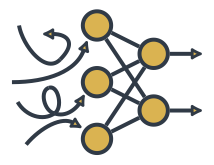SiMLInt

Simulation and Machine Learning Integration (simlint@mlist.is.ed.ac.uk)
SiMLInt ML Model Training Implementation
Following on from the data generation phase of our implementation for the Hasegawa-Wakatani example, this page describes how we train our ML models.
We are at the stage of having fine-grained simulation trajectories, and from those, extracted data for each timestep, coarsened that data, and run single-timestep coarse-grained simulations. We have then converted that data to NetCDF files that contain data at timestep 0 (gt_traj_{traj}.nc), the ground-truth data resulting from coarsening of the fine-grained simulation for trajectory {traj}, and at timestep 1 (sim_traj_{traj}.nc), the coarse-grained simulation output following a single time step.
The files in files/5-training take this data and perform: (1) error calculation; (2) ML model training and (3) freezing the models for use in simulations with LC.
-
Error calculation.
The error between these is calculated on-the-fly in files/5-training/data_read.py. This script loads all available gt_traj_{traj}.nc and sim_traj_{traj}.nc files, and generates raw coarse-grained and error data for two BOUT++ variables: ‘vort’ (the vorticity) and ‘n’ (the density).
-
Model.
files/5-training/model.py describes a convolutional neural network (CNN) that with 6 hidden layers that, given the coarse-grained data, aims to predict the error.
-
Training.
files/5-training/training.py is run on a GPU node on Cirrus via:
sbatch submit-training.sh --account $ACCOUNTTwo models are trained (one to correct vorticity and one to correct density) and frozen to file. Examples of these can be found in files/models. These will be loaded into the SmartRedis database for use during simulations.
-
Model location.
Model files produced should be placed in a folder for use in inference.
mkdir ${WORK}/models cp ${WORK}/data/training/model-hw-*.pb ${WORK}/models
The next step is to run a simulation with LC using SmartSim, BOUT++ and TensorFlow, with inference from the newly trained model.